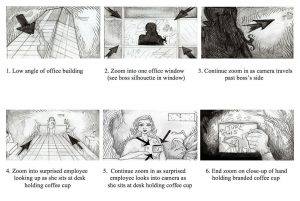What is a storyboard?
A storyboard is a shot by shot graphic representation based on your video’s script. It looks a little like a comic book, one that takes your video’s dialogue and visual sequences and translates them into shot-by-shot drawings. It’s the second big step in taking a video concept to screen, coming just after the important scripting stage.
How does it work?
Storyboarding should be a collaborative process between the client and the production company. Typically there will be at least one stage of feedback where the client studies and approves the storyboard or requests changes. The goal is to illustrate the vision for the client before getting to the expensive shooting stage.
Every phrase in the video’s script will be represented on the page in a frame, and sometimes with several frames if the line of the script requires multiple camera moves.
A line on paper like “ ZOOM IN from Exterior building through window past boss to stop on a branded coffee mug in the employee’s hand” might require several drawings to illustrate. Here is what that storyboard might look like:
 Why do it?
Why do it?
The production team may hire a storyboard artist. Particularly where a highly polished version is needed or when an animation is needed. Some directors can sketch a simple storyboard themselves by hand or by using still photos. Whether amateur or professionally drawn, a storyboard will contain ensure the client and crew can easily picture the video before filming begins.
Does Your Project Really Need a Storyboard?
Storyboarding does add some extra time and an extra cost into the pre-production process and not every video needs it. But in some cases, it offers certain advantages:
a) For visually complex sequences: You may not need to storyboard your entire video but complicated sequences with many camera moves or many people moving in and out of frame would benefit from it.
b) For better team communication: When everyone on the team knows what shots they are aiming to reproduce, misinterpretations or misunderstandings are reduced. Meanwhile, the client won’t be guessing or imagining, perhaps wrongly, about how shots and camera movements will unfold- they will confidently know what to expect.
c) Save production time & money: Pre-planning means less time and money used in the expensive production phase when equipment and crew members are charging by the hour. The crew goes in knowing what they need to achieve and can budget the right amount of time, equipment and crew to capture each sequence.
When don’t you need a storyboard?
While pre-visualizing concepts can be invaluable for complex sequences. Unpredictable live events, simple talking head videos or very basic visual sequences typically do not require the use of storyboarding.
Not sure if storyboarding can be an invaluable tool for your next corporate video? Contact us to get help get a clearer picture !
